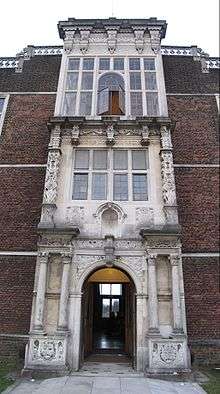Charlton House


Among several English houses with the name Charlton House, the most prominent is a Jacobean building in Charlton, London. It is regarded as the best-preserved ambitious Jacobean house in Greater London. It was built in 1607–12 of red brick with stone dressing, and has an "E"-plan layout. The interior features a great hall, chapel, state dining room, saloon and gallery.
The house was built by the crown to house Sir Adam Newton and his royal charge. He was then Dean of Durham and tutor to Prince Henry, the son of James I, and older brother of the future Charles I. Greenwich Palace, where their mother lived much of the time, was nearby. But the prince died almost as soon as the house was finished, in 1612. Newton became Receiver-General, sold his office as dean, and in 1620 became a baronet.
The diarist John Evelyn, who knew the house and was well acquainted with Newton's son, Sir Henry Newton, stated that the house had been built for Prince Henry. Because of Sir Adam's court connections, the designer of the house is often presumed to be John Thorpe, one of the first professional English architects, who had served as Clerk of Works for the royal palace at nearby Greenwich — the Palace of Placentia. Thorpe had left the Office of Works in 1601 for private practice.[1] Other royal connections are seen at Charlton House in the form of the Prince of Wales's feathers above the east door to the hall and in the saloon, where there is also the royal monogram, "JR" (for James I); the royal Stuart coat of arms in the west bay; and the Garter and Prince of Wales's motto, "Ich Dien" in the east bay.
The garden-house, or orangery, which has been converted into a public toilet, is optimistically attributed to Inigo Jones,[2] who is not otherwise connected with the house. Seemingly lurking behind the orangery is a Mulberry tree said to be the oldest of its species (Morus nigra) in the country, this old and venerable tree is thought to have been planted in 1608 at the behest of James I.
A wing was added by Norman Shaw in 1877. The house and grounds were used as a hospital during World War I and were bought by the Metropolitan Borough of Greenwich in 1925. The Chapel Wing was bombed during the Blitz and was subsequently rebuilt albeit with non-matching bricks such as were available in the immediate post-war period. Formerly housing a museum, the house is now a community centre, and much of the former pleasure grounds are parks, although remnants of the house gardens survive as does a short section of Ha-Ha.
The walled gardens and some of the perennial borders were redesigned and re-planted by the landscape designer Andrew Fisher Tomlin in 2003–2004 for the Royal Borough of Greenwich with perennial meadow planting to the main walled kitchen garden retaining three ancient Prunus app. trees. One of the spaces includes an Amnesty International Peace Garden with planting also designed by Fisher Tomlin.
Notes
- ↑ Colvin, Howard A Biographical Dictionary of British Architects, 1600–1840. 3rd ed., 1995. N.B. Colvin does not mention Charlton House in connection with Jones or Thorpe.
- ↑ Not by Colvin, however, who does not list it among "doubtful" attributions.
References
| Wikimedia Commons has media related to Charlton House. |
Coordinates: 51°28′50″N 0°02′13″E / 51.480633°N 0.037082°E